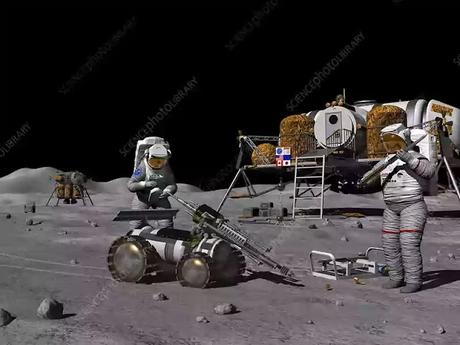Why we need to build a Lunar Base?
Many years have passed since Eugene Cernan closed the door of the LEM behind him, closing forever also the epic of the Apollo Missions.
But at that time it was not known that it would be for "ever", and on the contrary there was a lot of talk about the future of space exploration, Mars, and the great bases that we would certainly have built on the Moon by the end of the '70s.
Unfortunately, for many reasons, all this has never been realized, but after half a century it seems that the time has come to resume that discourse interrupted on the most beautiful. So we are back to talk about lunar bases, and to make plans for space exploration with human crews.
Many projects have already been started, and new competitors have joined the space race that has become mainly a race for mineral resources: Europe, China, India... and above all, the big private companies, led by businessmen, but also by brilliant visionaries.
Once again, however, we are held back by political uncertainty, which heavily conditions the strategies to be adopted. So that one of the big questions of the moment, that it dragged on for a long time will risk to bog down again the whole sector, is that of "better to bet on Mars or on the Moon"? To go directly to Mars or to implant the first stable bases on the Moon?
What does humanity gain by building a lunar base?
Today, the prospect of returning beyond low-earth orbit seems somehow more daunting, more dangerous, than it did when the Apollo program ended. Perhaps we know too much now; perhaps we are less reckless than we once were.
We understand better what can happen out there. Space can kill us. But we have to go, and so we will go. As always. Mars or the Moon, then? It's a strategic, political, and above all scientific choice. Many think or hope that the human journey to Mars can be accomplished by 2035.
However, we are talking about a demonstration mission, a "hit and run", if not even a flyby without the satisfaction of touching the surface. A bit like Apollo 10 did with the Moon. But then a complete colony or even a very spartan base to be planted on the red planet would take decades to accomplish. And perhaps the best way to learn how to do that is to practice on the Moon.
The Moon is only 380,000 km away and is, in the natural order of things, the first step in human space exploration. In fact, our natural satellite represents the first real opportunity for stable human settlement outside the Earth's atmosphere.
The International Space Station has had the very important task of consolidating our ability to operate, even for relatively long periods, in microgravity conditions and outside the atmosphere. However, to achieve a fully independent space outpost requires leaving low orbit and moving to the surface of another celestial body.
The closest opportunity to us is therefore the Moon, and the first, fundamental, step is to consolidate operations to our satellite. The exploratory missions of the '60s were dress rehearsals, demonstrations of technological capability, as well as operational, but they represent only a taste of the real challenge that awaits us: to ensure long stays on a celestial body different from ours, building settlements that can, one day, sustain themselves in total autonomy.

There is in fact a fundamental difference between demonstrating the ability to go and return safely and permanently inhabiting a planet different from Earth. Creating self-sustaining settlements outside of our planet is the real goal that has never been attempted to date and implies the ability to reinvent the manufacturing process on another celestial body that includes the extraction of raw materials and subsequent processing in situ.
In addition to this, it should be added that the now confirmed presence of water makes extremely realistic the hypothesis of human settlements. Scientific research, of course, would certainly be one of the main objectives of a permanent settlement, but the effort would be primarily aimed at the development of technological capacity.
In a long-term perspective, once developed the transport system capable of ensuring the connections "Earth-Moon", the Moon could also become a sort of giant industrial zone: a place where decentralize the highly polluting production activities, lowering the negative impact they currently have on the Earth's ecosystem.
In addition, because it has low gravity and no substantial atmosphere, the Moon is destined to become our spaceport par excellence.
A lunar base could therefore one-day ensure human and robotic expeditions to the edge of the solar system and beyond; and offer explorers the opportunity to learn how to live in hostile, low-gravity environments and test the technologies necessary for their survival.
Establishment of a colony on a celestial body
Typically, the establishment of a colony on a celestial body involves the provision of large quantities of materials for the construction of the base itself, as well as for other uses, including radiation shielding.
The energy required to launch cargo from the moon into space is much less than that required to perform the same operation from Earth, which will allow the Moon to serve as a construction site or supply station for spacecraft.
The proximity of the Moon also gives other invaluable advantages when the project is to build something on the surface of another celestial body. Let us try to enumerate them together. A very short travel time; the astronauts of the Apollo missions covered the Earth-Moon distance in three days.
Such a short time allows both to quickly send possible rescue missions from Earth and to quickly evacuate the crew of the lunar base. For comparison, the distance to Mars with current technology would require 6-9 months of travel, which would make any serious problems occurring inside the base lethal. The costs for the initial establishment of a base on the Moon would then be much less than for a colony on Mars... at least by a factor of 30.

The telecommunications delay between Earth and the Moon is 1.2 seconds, which does not prevent normal voice and video conversations. For comparison, the delay with Mars ranges from about eight to forty minutes.
This could be crucial in the early stages of colony establishment, where emergencies and critical situations could take advantage of near real-time assistance from Earth (an example of this was the Apollo 13 mission). On the near side of the Moon, the Earth appears large and always visible, while on Mars when it is visible it appears as a star. The crew of a lunar colony would feel psychologically less distant from Earth.
A lunar base would be an excellent site for an astronomical observatory. Because of the Moon's slow rotation, observations in visible light could last for entire days. It would also be possible to keep a target under constant observation through a series of observatories distributed around the lunar circumference.
A radio telescope on the Moon could be much larger than that of Arecibo because of the low gravity and also the dish could be easily built inside a crater, simply by covering the cavity in aluminum.
Moreover, the Moon is geologically dead, this- combined with the absence of widespread human activity - makes almost absent the disturbances from mechanical vibration and therefore more efficient interferometry telescopes.
Finally, it must be taken into account that on the Moon there could be deposits of minerals considered rare on Earth (such as titanium, gold, palladium, iridium, and uranium) but also deposits of more common minerals (such as iron, nickel, aluminum); not to mention water, available in large quantities in the form of ice in polar regions, and not to forget that on the Moon was found helium-3, an element that could be used by nuclear fusion power plants, both terrestrial and lunar. However, this concerns a future still quite far, when we will be able to find a way to master the fusion process.
Disadvantage

If we want, the only disadvantages compared to a similar settlement on Mars come from the force of gravity and radiation raining down from space. There is uncertainty as to how much lunar gravity (one-sixth of what we experience on Earth's surface, and half of what we experience on Mars) is sufficient to prevent the long-term wasting phenomena of the human organism.
Exposure to weightlessness for periods of time on the order of months has been shown to create a reduction in bone and muscle mass, as well as a depression of the immune system. Similar effects are produced by a low-gravity environment, although the only experimental evidence we have so far relates to zero-gravity environments.
Daily exercise appears to be partially effective in preventing the effects of zero gravity. The absence of an atmosphere makes the lunar surface exposed to large temperature changes and radiation levels comparable to those experienced in the vacuum of interplanetary space. Also increasing the risk of impact from meteors.
Another small disadvantage compared to Marsis that the solar panels, to provide energy, on the Moon are not effective. They can work only half the time: during the lunar night, everything is in the dark. It will be necessary to make use of small nuclear reactors, as the Apollo astronauts already did to provide power to their scientific equipment.
But they were radioisotope generators, less powerful, while in the future will be necessary real reactors. Apart from that, it would seem therefore forced choice that of the Moon... and besides, barring a resounding about-turn by the incomingBiden presidency, the road seems already marked by the political decision of Trump and the scientific decision of NASA to start Project Artemis (goddess of the Moon and sister of apollo), intended to bring a human crew on the lunar surface in 2024.
But fingers crossed. Too often we've seen a change of course in space policy due to a renewal of the top of the command line: Moon with Bush, Mars with Obama, then Moon again with Trump, now perhaps Mars with the Moon as an intermediate step.
Huge waste of resources, not to mention all the design energy burned on the altar of specious ideological differences. However, NASA has also started to theorize about subsequent missions, maybe for 2026, in which they foresee the use of a module to allow a short stay on the Moon, but obviously, that will not be considered a real base...structure that we could have maybe in 2030, not before.
The goal is the Artemis Base Camp, which will include new rovers, power generation systems, inhabited modules, and everything needed to support a view of the Moon, including technologies capable of extracting water and materials. Once the base is operational, astronauts will be able to move to more remote regions of the Moon.
Whether or not they go to the Moon or Mars, the years ahead will be filled with unprecedented adventures and scientific discoveries. This time, however, NASA and the United States will not be the only players in the game.
Space has now become a stage

Space has now become a stage on which private investors such as SpaceX and Blue Origin are also moving, and likewise, companies and agencies in other countries are beginning to invest in space infrastructure. China's space agency, for example, has shown a clear interest in the Moon, as have Europe, Russia, and India... All agree on the creation of permanent bases: initially in lunar orbit and then on the surface of the satellite.
It is, however, not an easy task. The first problem is related to the fact that all participants in the "lunar race" intend to grab the same resources and the same places. For this reason, even today the debate is essentially concerned not so much with the scientific aspects of the question as with the legal and commercial ones.
For example, in all lunar programs, the area selected for the permanent base is the lunar South Pole, although from a purely technical point of view flights to and from the orbital station are easier to be made from the equatorial zone of the satellite.
But just in the area of the lunar South Pole concentrated the so-called "cold traps", i.e. areas perennially in shadow, covered with ice And the beauty of the whole issue is that there is currently no legal treaty able to regulate the lawfulness and the eventual sharing of mining activities. Should we start worrying about that too? What do you think?
Credits: Ron Miller, MarkGarlick.com Photo Credits: Nasa/Shutterstock/Storyblocks/Elon Musk/SpaceX/ESA/ESO

